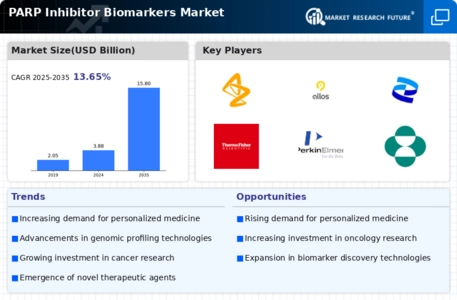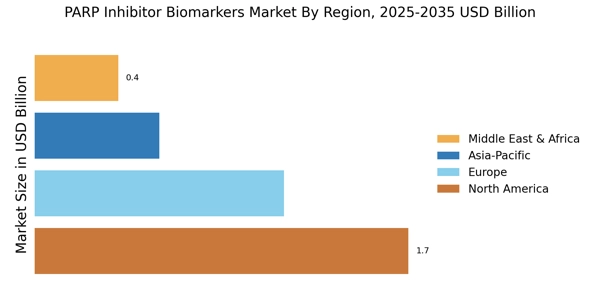Increasing Cancer Prevalence
The rising incidence of various cancers, particularly breast and ovarian cancers, is a primary driver for the PARP Inhibitor Biomarkers Market. As cancer cases continue to escalate, the demand for effective treatment options intensifies. According to recent statistics, the number of new cancer cases is projected to reach millions annually, necessitating innovative therapies. PARP inhibitors have emerged as a promising solution, particularly for patients with BRCA mutations. This growing patient population is likely to propel the market forward, as healthcare providers seek targeted therapies that can improve patient outcomes. The increasing awareness of genetic testing further supports this trend, as more patients are identified as candidates for PARP inhibitor therapies, thereby expanding the market's reach.
Growing Investment in Cancer Research
The increasing investment in cancer research is a significant driver for the PARP Inhibitor Biomarkers Market. Governments, private organizations, and pharmaceutical companies are allocating substantial resources to explore novel cancer therapies, including PARP inhibitors. This influx of funding supports clinical trials and research initiatives aimed at understanding the mechanisms of action of PARP inhibitors and their efficacy in various cancer types. As research progresses, new insights into the role of biomarkers in predicting treatment responses are likely to emerge, further enhancing the market's potential. The commitment to advancing cancer research not only fosters innovation but also raises awareness about the importance of biomarker-driven therapies, thereby expanding the market landscape.
Rising Demand for Combination Therapies
The increasing demand for combination therapies is shaping the PARP Inhibitor Biomarkers Market. Oncologists are increasingly recognizing the potential of combining PARP inhibitors with other treatment modalities, such as chemotherapy and immunotherapy, to enhance therapeutic efficacy. This trend is driven by the understanding that multi-faceted approaches may lead to improved patient outcomes and reduced resistance to treatment. Clinical studies have shown promising results when PARP inhibitors are used in conjunction with other agents, leading to a surge in interest from both clinicians and patients. As the paradigm shifts towards combination therapies, the market for PARP inhibitors is expected to grow, as healthcare providers seek to optimize treatment regimens for cancer patients.
Regulatory Support for Targeted Therapies
Regulatory bodies are increasingly supporting the development and approval of targeted therapies, which is a crucial driver for the PARP Inhibitor Biomarkers Market. Recent initiatives aimed at expediting the approval process for innovative cancer treatments have created a favorable environment for the introduction of PARP inhibitors. For instance, the FDA has implemented programs that prioritize the review of drugs targeting specific genetic mutations, such as those found in BRCA genes. This regulatory support not only accelerates the availability of new therapies but also encourages pharmaceutical companies to invest in the development of PARP inhibitors. As more targeted therapies receive regulatory approval, the market is likely to expand, providing patients with access to cutting-edge treatment options.
Technological Advancements in Biomarker Discovery
Technological innovations in biomarker discovery are significantly influencing the PARP Inhibitor Biomarkers Market. The advent of next-generation sequencing and advanced bioinformatics tools has enhanced the identification of biomarkers associated with PARP inhibitors. These technologies facilitate the rapid analysis of genetic variations, enabling the development of more precise and effective treatment strategies. As a result, pharmaceutical companies are increasingly investing in research and development to discover new biomarkers that can predict patient responses to PARP inhibitors. This trend is expected to drive market growth, as the ability to tailor treatments based on individual biomarker profiles becomes more prevalent. The integration of these technologies into clinical practice may also lead to improved patient stratification and outcomes.


















Leave a Comment